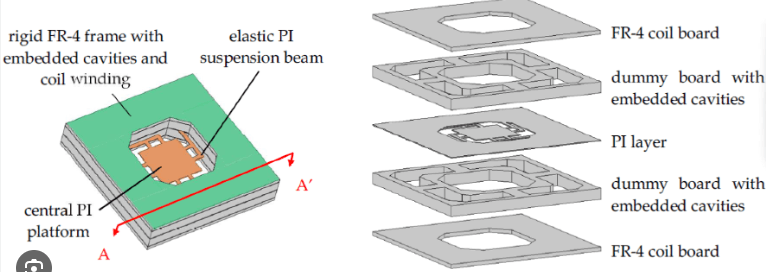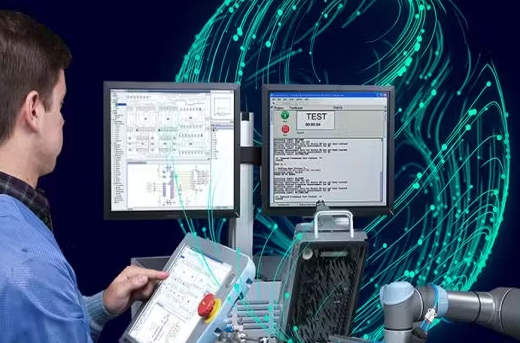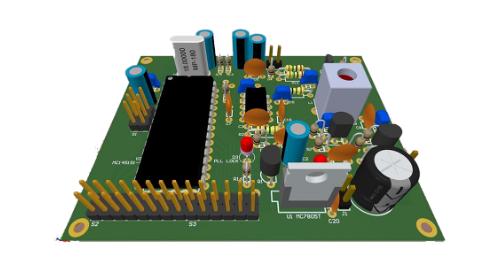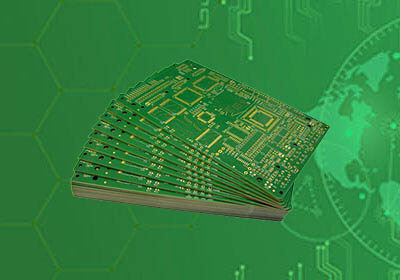Rigid flex pcb construction
Advantages Of Rigid Flex PCB Construction
Rigid flex PCB construction offers a multitude of advantages that make it an increasingly popular choice in various industries. One of the primary benefits is its ability to combine the best features of both rigid and flexible circuit boards. This hybrid construction allows for greater design versatility, enabling engineers to create more complex and compact electronic devices. By integrating rigid and flexible substrates, rigid flex PCBs can be designed to fit into tight spaces and conform to unique shapes, which is particularly advantageous in applications where space is at a premium.
Another significant advantage of rigid flex PCB construction is its enhanced reliability.
The seamless integration of rigid and flexible layers reduces the number of interconnects and solder joints, which are common points of failure in traditional PCB assemblies. This reduction in potential failure points leads to improved overall durability and longevity of the electronic device. Additionally, the flexible layers can absorb and dissipate mechanical stress, further enhancing the robustness of the circuit. This makes rigid flex PCBs ideal for use in environments subject to vibration, shock, or other mechanical stresses.
The weight and space savings offered by rigid flex PCBs are also noteworthy.
By eliminating the need for multiple connectors and cables, these PCBs can significantly reduce the overall weight and volume of the electronic assembly. This is particularly beneficial in applications such as aerospace, medical devices, and portable electronics, where minimizing weight and size is crucial. The streamlined design not only contributes to the device’s performance but also facilitates easier assembly and maintenance.
Moreover, rigid flex PCB construction can lead to cost savings in the long run.
Although the initial manufacturing costs may be higher compared to traditional PCBs, the reduction in assembly time, fewer required components, and enhanced reliability can result in lower overall costs. The simplified assembly process reduces labor costs and the potential for human error, while the increased reliability minimizes the need for repairs and replacements. Consequently, the total cost of ownership for devices utilizing rigid flex PCBs can be lower over their lifespan.
In addition to these practical benefits, rigid flex PCBs also offer superior electrical performance.
The close proximity of the rigid and flexible layers allows for shorter signal paths, which can reduce signal loss and improve overall electrical performance. This is particularly important in high-speed and high-frequency applications, where maintaining signal integrity is critical. The ability to design more efficient and reliable circuits can lead to better-performing electronic devices.
Furthermore, the versatility of rigid flex PCB construction extends to its compatibility with a wide range of materials and components.
This flexibility allows designers to select the most appropriate materials for their specific application, optimizing performance and durability. The ability to incorporate various components, such as surface-mount devices and through-hole components, further enhances the design possibilities.
In conclusion, the advantages of rigid flex PCB construction are manifold, encompassing design versatility, enhanced reliability, weight and space savings, cost efficiency, superior electrical performance, and material compatibility. These benefits make rigid flex PCBs an attractive option for a wide range of applications, from consumer electronics to aerospace and medical devices. As technology continues to advance, the demand for more compact, reliable, and high-performing electronic devices will likely drive further adoption of rigid flex PCB construction.

Key Materials Used In Rigid Flex PCB Manufacturing
Rigid flex PCB construction is a sophisticated process that combines the best attributes of both rigid and flexible circuit boards. This hybrid technology is increasingly popular in various industries, including aerospace, medical devices, and consumer electronics, due to its ability to provide enhanced reliability and design flexibility. Understanding the key materials used in rigid flex PCB manufacturing is essential for appreciating the complexity and precision involved in creating these advanced circuits.
To begin with, the foundation of any rigid flex PCB is the substrate material.
The rigid sections typically use FR-4, a glass-reinforced epoxy laminate known for its excellent mechanical strength and electrical insulation properties. FR-4 is widely favored due to its stability under varying environmental conditions and its cost-effectiveness. On the other hand, the flexible sections employ polyimide films, such as Kapton, which offer superior flexibility, thermal stability, and chemical resistance. Polyimide’s ability to withstand high temperatures without deforming makes it an ideal choice for the dynamic parts of the circuit.
Transitioning from the substrate materials, the next critical component is the conductive layers.
Copper is the material of choice for these layers due to its excellent electrical conductivity and ductility. In rigid flex PCBs, copper foils are laminated onto the substrate materials through a process called copper cladding. This ensures a uniform and reliable conductive path across both rigid and flexible sections. The thickness of the copper layers can vary depending on the specific requirements of the application, with thicker layers providing lower resistance and higher current-carrying capacity.
In addition to the conductive layers, the adhesive materials used in rigid flex PCB construction play a pivotal role.
These adhesives bond the different layers together, ensuring structural integrity and electrical performance. Epoxy-based adhesives are commonly used for their strong bonding properties and resistance to environmental factors such as moisture and temperature fluctuations. In flexible sections, acrylic-based adhesives are often preferred due to their flexibility and ability to maintain adhesion under repeated bending and flexing.
Furthermore, the protective coatings and finishes applied to rigid flex PCBs are crucial for their longevity and performance.
Solder masks, typically made from epoxy or polyimide, are applied to protect the copper traces from oxidation and short circuits. These masks also help in defining the areas where soldering will occur, ensuring precise component placement. Additionally, surface finishes such as ENIG (Electroless Nickel Immersion Gold) or HASL (Hot Air Solder Leveling) are applied to the exposed copper pads to enhance solderability and protect against corrosion.
Moreover, the importance of via technology in rigid flex PCB construction cannot be overstated.
Vias are small holes drilled through the PCB layers to create electrical connections between different layers. In rigid flex PCBs, microvias and blind/buried vias are often used to optimize space and improve electrical performance. These vias are typically filled with conductive materials such as copper or conductive epoxy to ensure reliable connections.
In conclusion, the construction of rigid flex PCBs involves a meticulous selection of materials, each chosen for its specific properties and performance characteristics. From the robust FR-4 and flexible polyimide substrates to the conductive copper layers and specialized adhesives, every material plays a vital role in the overall functionality and reliability of the final product. Understanding these key materials provides valuable insight into the complexity and precision required in rigid flex PCB manufacturing, highlighting the advanced nature of this technology.

Design Considerations For Rigid Flex PCBs
When designing rigid-flex printed circuit boards (PCBs), several critical considerations must be taken into account to ensure optimal performance and reliability. The unique structure of rigid-flex PCBs, which combines the benefits of both rigid and flexible substrates, necessitates a thorough understanding of material properties, mechanical constraints, and electrical performance requirements. By carefully addressing these factors, designers can create robust and efficient solutions for a wide range of applications.
One of the primary considerations in rigid-flex PCB design is the selection of appropriate materials.
The rigid sections typically use standard FR4 or similar materials, while the flexible sections employ polyimide or other flexible substrates. The choice of materials impacts not only the mechanical properties but also the thermal and electrical performance of the PCB. It is essential to ensure that the materials used can withstand the operating environment, including temperature variations and potential exposure to harsh chemicals or mechanical stress.
Another crucial aspect is the layer stack-up configuration.
Rigid-flex PCBs often consist of multiple layers, with some layers being rigid and others flexible. The stack-up must be carefully planned to balance the mechanical flexibility with the need for electrical connectivity and signal integrity. Designers must consider the placement of vias and through-holes, as these can introduce stress points that may lead to failure if not properly managed. Additionally, the use of blind and buried vias can help optimize space and improve the overall performance of the PCB.
The mechanical design of rigid-flex PCBs also requires careful attention to the bend radius and flexing requirements.
The flexible sections must be designed to accommodate the expected range of motion without causing damage to the conductive traces or the substrate. This involves calculating the minimum bend radius, which is typically a function of the material thickness and the number of layers. Exceeding the recommended bend radius can result in cracking or delamination, compromising the integrity of the PCB.
Signal integrity is another vital consideration in rigid-flex PCB design.
The transition between rigid and flexible sections can introduce impedance discontinuities, which may affect high-speed signal transmission. To mitigate these effects, designers should employ controlled impedance techniques and carefully route high-speed traces. Additionally, the use of ground planes and proper shielding can help minimize electromagnetic interference (EMI) and ensure reliable signal performance.
Thermal management is also a key factor in the design of rigid-flex PCBs.
The combination of rigid and flexible materials can create challenges in dissipating heat, particularly in high-power applications. Designers must consider the thermal conductivity of the materials and incorporate appropriate heat dissipation mechanisms, such as thermal vias, heat sinks, or conductive adhesives. Proper thermal management ensures that the PCB operates within safe temperature limits, preventing overheating and potential failure.
Finally, manufacturability and assembly considerations play a significant role in the design process.
Rigid-flex PCBs require specialized fabrication techniques, and designers must work closely with manufacturers to ensure that the design can be produced reliably and cost-effectively. This includes considering factors such as panelization, routing, and the use of stiffeners or other support structures. Additionally, the assembly process must account for the handling and placement of components on both rigid and flexible sections, ensuring that the final product meets the required specifications.
In conclusion, designing rigid-flex PCBs involves a complex interplay of material selection, mechanical design, signal integrity, thermal management, and manufacturability. By carefully addressing these considerations, designers can create high-performance, reliable PCBs that leverage the unique advantages of rigid-flex technology. This holistic approach ensures that the final product meets the demanding requirements of modern electronic applications, from consumer electronics to aerospace and medical devices.

Common Applications Of Rigid Flex PCBs
Rigid flex PCBs, a hybrid of rigid and flexible circuit boards, have become increasingly popular in various industries due to their unique combination of durability and flexibility. These advanced circuit boards are designed to meet the demands of complex electronic applications, offering a versatile solution that can be tailored to specific needs.
One of the most common applications of rigid flex PCBs is in the aerospace industry.
In this sector, the need for lightweight, reliable, and compact electronic systems is paramount. Rigid flex PCBs are ideal for aerospace applications because they can withstand extreme conditions, including high temperatures and vibrations, while maintaining their structural integrity. This makes them suitable for use in avionics, satellite systems, and other critical aerospace components.
Another significant application of rigid flex PCBs is in the medical field.
Medical devices often require compact and reliable electronic systems that can perform accurately under various conditions. Rigid flex PCBs are used in medical devices such as pacemakers, hearing aids, and diagnostic equipment. Their ability to conform to different shapes and sizes allows for the miniaturization of medical devices, making them more comfortable and less invasive for patients. Additionally, the reliability and durability of rigid flex PCBs ensure that these medical devices function correctly over extended periods, which is crucial for patient safety.
The consumer electronics industry also benefits greatly from the use of rigid flex PCBs.
As electronic devices become smaller and more complex, the need for compact and efficient circuit boards has grown. Rigid flex PCBs are used in smartphones, tablets, and wearable technology, where space is at a premium, and performance cannot be compromised. Their flexibility allows for innovative designs and the integration of multiple functions into a single device, enhancing the user experience. Moreover, the durability of rigid flex PCBs ensures that consumer electronics can withstand daily wear and tear, extending the lifespan of these devices.
In the automotive industry, rigid flex PCBs are employed in various applications, including advanced driver-assistance systems (ADAS), infotainment systems, and engine control units.
The automotive environment is challenging, with exposure to high temperatures, vibrations, and harsh chemicals. Rigid flex PCBs are well-suited to these conditions, providing reliable performance and reducing the risk of failure. Their ability to fit into tight spaces and conform to the contours of the vehicle’s design also allows for more efficient use of space, contributing to the overall efficiency and functionality of automotive systems.
Furthermore, the industrial sector utilizes rigid flex PCBs in a range of applications, from robotics to control systems.
Industrial environments often involve exposure to harsh conditions, including extreme temperatures, moisture, and mechanical stress. Rigid flex PCBs offer the robustness needed to operate reliably in these settings. They are used in industrial automation systems, where precision and reliability are critical, as well as in sensors and monitoring equipment that require flexible yet durable circuit solutions.
In conclusion, the versatility and reliability of rigid flex PCBs make them an essential component in various industries. Their ability to combine the best features of rigid and flexible circuit boards allows for innovative designs and applications that meet the specific needs of each sector. From aerospace and medical devices to consumer electronics, automotive systems, and industrial applications, rigid flex PCBs provide a robust and adaptable solution that enhances the performance and reliability of electronic systems. As technology continues to advance, the demand for rigid flex PCBs is likely to grow, driving further innovation and development in this field.






